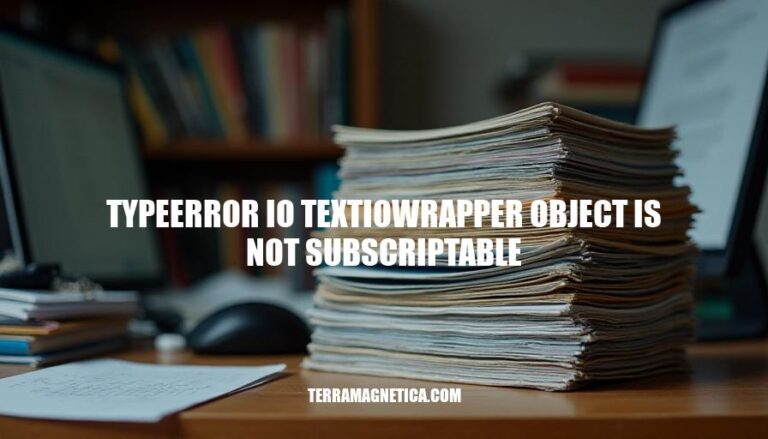


The TypeError: 'io.TextIOWrapper' object is not subscriptable error in Python occurs when you try to use indexing or slicing on a file object. This error typically happens when you attempt to access elements of a file object as if it were a list or a string. File objects in Python, such as those created using the open() function, do not support subscripting. Instead, you should use methods like read(), readline(), or readlines() to access the content of the file.
Would you like to see an example of how to avoid this error?
The TypeError: 'io.TextIOWrapper' object is not subscriptable error occurs when you try to use indexing (e.g., file[0]) on a TextIOWrapper object. This object is a file handler used for reading and writing text files in Python.
[] on a file object.with open('example.txt', 'r') as file:
print(file[0]) # Raises TypeError
TextIOWrapper Object?TextIOWrapper object is a file object that provides methods for reading and writing text data. It wraps a buffered binary stream and handles encoding and decoding of text.read(), readline(), readlines(), write(), and writelines().TextIOWrapper objects are not sequence types like lists or strings. They do not implement the __getitem__() method, which is required for an object to support indexing.read() or readlines() to retrieve data in a suitable format (e.g., a string or list).If you need to access specific lines or characters, read the file content into a list or string first:
with open('example.txt', 'r') as file:
lines = file.readlines()
print(lines[0]) # Access the first line
This approach avoids the TypeError by working with a subscriptable object (a list) instead of the file object directly.
Developers often encounter the TypeError: '_io.TextIOWrapper' object is not subscriptable error when they mistakenly try to use indexing on a file object. Here are some common scenarios:
Trying to access a specific line directly from a file object:
file = open('example.txt', 'r')
print(file[0]) # This will raise the TypeError
Attempting to index a file object instead of reading its content first:
with open('example.txt', 'r') as file:
first_char = file[0] # This will raise the TypeError
Using a file object in a context where a list or string is expected:
def process_data(data):
return data[0]
with open('example.txt', 'r') as file:
result = process_data(file) # This will raise the TypeError
In these examples, the error occurs because file objects do not support indexing. To avoid this, you should read the file content into a list or string first, then perform indexing on that list or string.
Here’s a step-by-step guide to troubleshoot and resolve the TypeError: 'io.TextIOWrapper' object is not subscriptable error, along with alternative methods to achieve the desired outcome:
Identify the Error Source:
[] on) a file object.Understand the Cause:
_io.TextIOWrapper) do not support indexing. They are not subscriptable like lists or strings.Correct the Code:
with open('example.txt', 'r') as file:
first_line = file[0] # This will raise the TypeError
Use the readlines() method to read the file into a list of lines, which is subscriptable.
with open('example.txt', 'r') as file:
lines = file.readlines()
first_line = lines[0] # Access the first line
Using read() and Splitting:
with open('example.txt', 'r') as file:
content = file.read()
lines = content.splitlines()
first_line = lines[0]
Using readline() in a Loop:
with open('example.txt', 'r') as file:
first_line = file.readline()
Using List Comprehension:
with open('example.txt', 'r') as file:
lines = [line for line in file]
first_line = lines[0]
These methods ensure you avoid the TypeError by correctly handling file objects.
Here are some best practices to avoid the TypeError: 'io.TextIOWrapper' object is not subscriptable error:
Read File Content Properly:
read(), readline(), or readlines() methods to read file content.with open('file.txt', 'r') as file:
content = file.read()
Convert to Subscriptable Types:
with open('file.txt', 'r') as file:
lines = file.readlines()
first_line = lines[0]
Check Object Type:
if isinstance(obj, (list, str, tuple)):
element = obj[0]
Use Context Managers:
with statements to handle files, ensuring proper closure.with open('file.txt', 'r') as file:
for line in file:
print(line)
Avoid Direct Indexing on File Objects:
# Incorrect
with open('file.txt', 'r') as file:
char = file[0] # This will raise the error
By following these practices, you can prevent the TypeError and ensure smoother file handling in your projects. Happy coding!
The ‘TypeError: io.TextIOWrapper object is not subscriptable’ error occurs when trying to access file objects using indexing, which is not allowed in Python. To avoid this error, it’s essential to understand how file objects work and use the correct methods for reading and manipulating file content.
read(), readline(), or readlines() methodswith statements) to handle files and ensure proper closureBy following these best practices, developers can prevent the ‘TypeError: io.TextIOWrapper object is not subscriptable’ error and write more efficient and effective Python code. Understanding and properly handling this error is crucial for smooth file handling in projects, making it a vital aspect of Python programming.